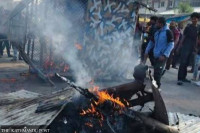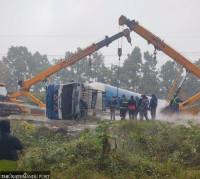Madhesh Province
Birgunj locals march to Kathmandu to highlight Sirsiya River pollution
Factories along Parsa-Bara corridor release untreated wastewater into the river.
Bhusan Yadav
Sirsiya River that flows through Birgunj, a major business and industrial hub in Parsa district of Madhesh Province, has become highly polluted due to the toxic industrial waste generated by several factories on the Parsa-Bara Industrial Corridor. The factories release untreated waste into the river, locals say, resulting in the river turning into an open sewer.
In an apparent bid to exert pressure on authorities concerned and to bring to light the worsening water pollution in Sirsiya River, 10 days ago, a group of Birgunj residents set off on a march to Kathmandu carrying the polluted water from the river. The march that started on May 18 finally reached the Capital on Saturday evening through Hetauda, Narayanghat and Muglin.
“The initiatives of the local government were not enough to control pollution in Sirsiya. So we decided to launch the long march to Kathmandu to put pressure on the federal government to look into the matter,” said Saroj Raya, patron of Chure Forest Conservation Campaign. According to him, a group of 25 people are participating in the march. “We walked around 25 kilometres a day. We plan to hand over the polluted water to the government in Singha Durbar.”
The locals of Het settlement in Jitpur Simara sub-metropolitan city-23 of Bara district where the river originates and flows towards the middle Ganga plains in India say the water in the Bara section of the river is clean enough for household use.
“However, by the time the river reaches Parwanipur in Birgunj-21 just one and a half kilometres downstream, the river turns toxic as a result of the waste released into the river by factories and industries,” said Ajija Miya of Parwanipur. “The river no longer supports aquatic life. The water is unfit for consumption even by the cattle. It’s hard to believe that until a few years ago, people used to bathe and wash in the river in the Parwanipur area.”
The factories along the Parsa-Bara industrial corridor frequently release untreated waste into the river, giving its water a perpetually murky hue. Earlier, water from the same river was used for drinking and washing by households in more than a dozen VDCs in Parsa and Bara districts. “Today, the river is so polluted that its water has become unsupportive of any form of life,” said Miya.
Various textile, pharmaceutical, leather and meat factories, among others, line the corridor. “The river emits a foul smell. It is becoming increasingly difficult to go anywhere near it,” said Sabdar Hussein of Parwanipur. According to him, most of the factories along the corridor have water treatment plants, but they don’t treat the wastewater before emptying it into the river.
The Sirsiya river, which originates from Ramban forest in Jitpur Simara-3 of Bara, has cultural significance as well. It is an important water body for devotees during Chhath, a major Hindu festival in the central Tarai. The devotees are hit hardest by the pollution.
Chhath organisers have for the past several years been urging the district administration to take initiatives to control river pollution, at least during Chhath, which is celebrated for five days. On the instructions of the district administration office, the factories are closed during Chhath and the pollution in the Sirsiya river automatically comes down for a few days, say locals.

Some factories along the corridor were set up some eight decades ago. Over time, their numbers have multiplied. Since the 1970s, the pollution level in the river has increased significantly.
The local people of Simara, Tajapur, Parwanipur, Lohasanda, Ramauli, Jagarnathpur, Rampur Tokani, Sagardina, Chhatapipara, Nitanpur, Gamhargaon, Ramgadhawa, Ranighat, Sirsiya Khalwatol, and Birgunj metropolis sections along the Parsa-Bara industrial area are hugely affected by the river pollution. The deterioration of the river makes life difficult also for the residents of the East Champaran district of Bihar, India.
A study conducted by the then Ministry of Population and Environment seven years ago shows that as many as 250 factories discharged polluted waters and chemicals directly into the Sirsiya. Earlier, the district administration office in Parsa had formed a committee to study the pollution in the river. The committee’s report had pointed to industrial discharge as the main cause of river pollution.
Birgunj Metropolitan City formed the Sirsiya River Pollution Control Committee chaired by deputy mayor Imtiyaz Alam a few months ago. The committee monitors the factories and businesses in the area. According to Laxmi Prasad Paudel, chief administrative officer, the committee in March decided to fine five firms Rs300,000 each for polluting the river in the month. But the firms have yet to pay the fine.
“We are coordinating with the Birgunj Chamber of Commerce and Industry to control pollution in Sirsiya. The process to scrap the licence of the factories that have not paid the fine is underway,” said Mayor Rajeshman Singh.
At the initiative of the Birgunj chamber, a gathering of industrialists on the Parsa-Bara corridor was held in Birgunj in January. Sirsiya River pollution was the main agenda of the gathering. The industrialists had agreed to set up water treatment plants at their factories within a week and promised to release only treated water into the river. But they never kept their promise.




 6.06°C Kathmandu
6.06°C Kathmandu












